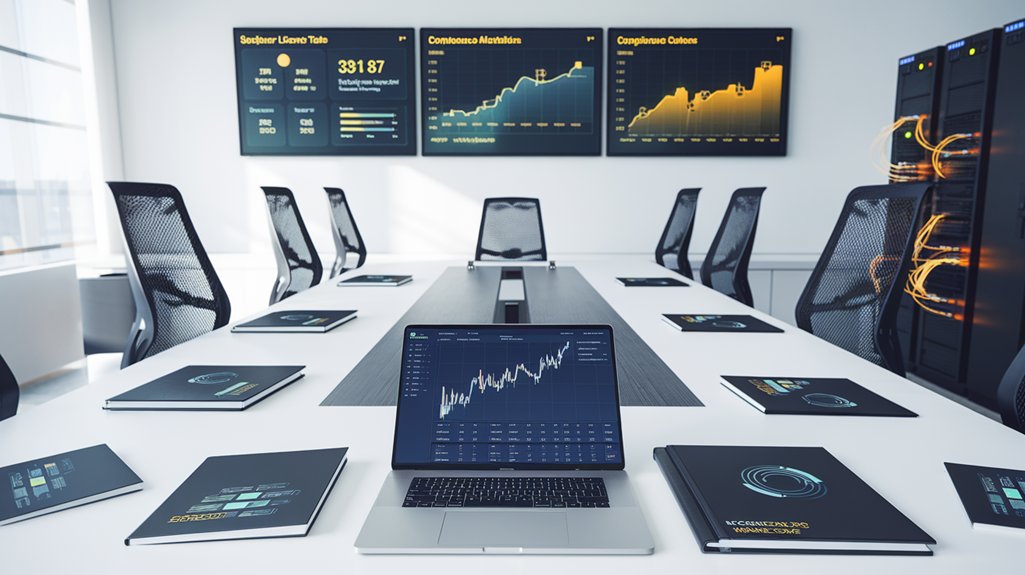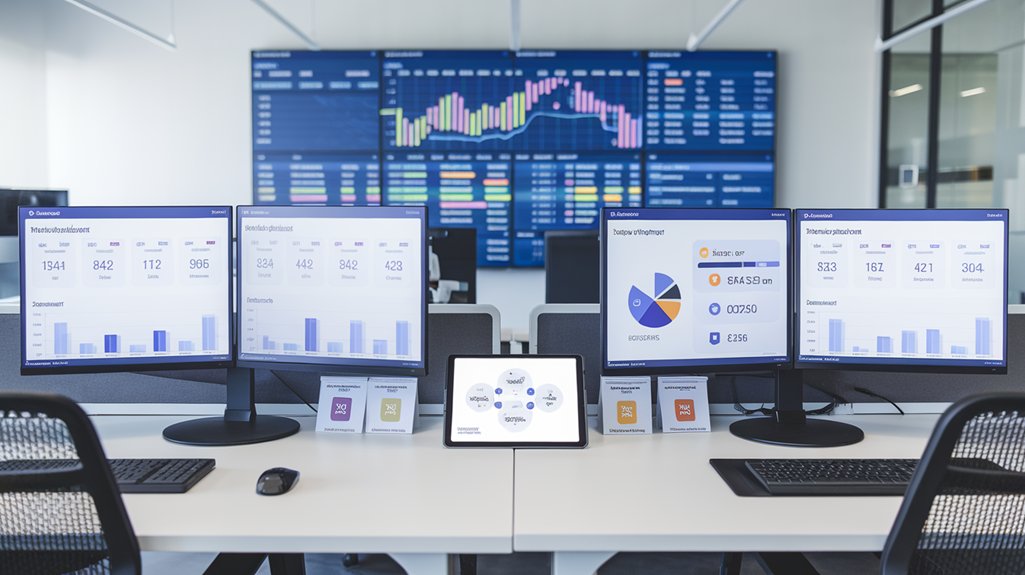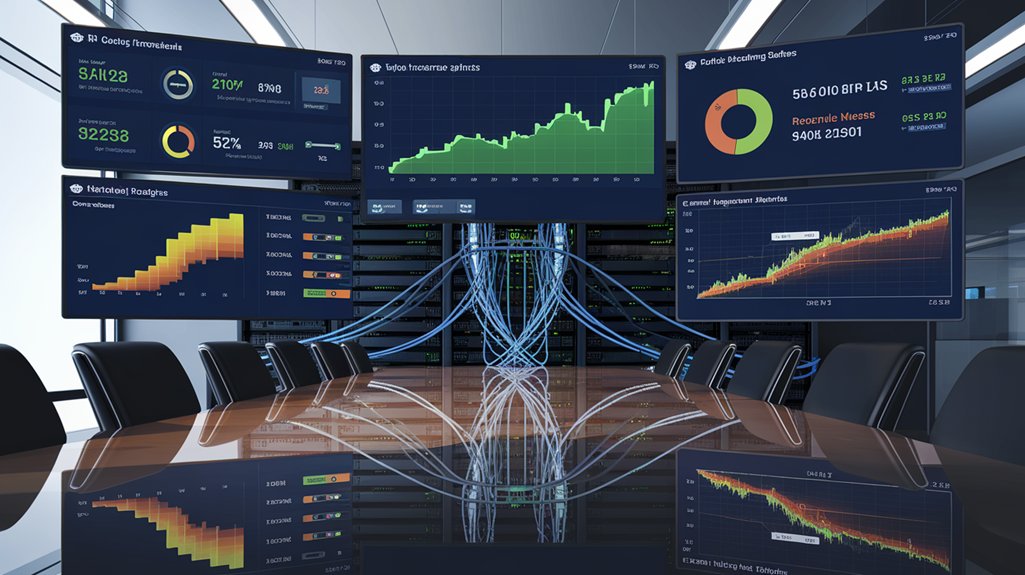SAM maintenance responsibilities are distributed across three key roles: the SAM Manager oversees the program and coordinates between departments; SAM Specialists handle daily operations including data validation and compliance monitoring; and License Administrators manage license inventory and compliance with vendor agreements. Effective SAM maintenance also requires collaboration between IT and procurement departments through regular meetings and data sharing. Success in SAM maintenance is measured through KPIs like compliance rates, cost savings, and inventory accuracy. Further exploration reveals how these roles integrate for ideal software asset management.
Core Team Members and Their Responsibilities in SAM Maintenance

The foundation of effective Software Asset Management (SAM) rests on a well-structured core team with clearly defined responsibilities. This team typically includes five key roles working in coordinated fashion to maintain system integrity.
The SAM Manager responsibilities encompass program oversight, team leadership, audit coordination, and policy development. As the central authority, they guarantee alignment between SAM operations and organizational objectives while serving as the liaison between departments. Similar to federal contractors, they must maintain strict documentation and reporting standards.
SAM Specialist tasks focus on daily operational elements, including data validation, compliance monitoring, and system access management. These specialists track software usage patterns, identify optimization opportunities, and support the procurement process.
License Administrators play a crucial role in managing the organization’s license inventory and ensuring ongoing compliance with vendor agreements. They must implement routine inspections to identify potential compliance issues before they become problematic.
Cross-functional collaboration remains essential, with regular coordination meetings guaranteeing all team members maintain alignment on asset lifecycle management and licensing compliance status throughout the organization.
Bridging the Gap: How IT and Procurement Collaborate on SAM Updates

Effective SAM maintenance extends beyond the core team to require strategic partnerships between IT and procurement departments. This collaboration benefits organizations through shared goal alignment, ensuring both cost management and compliance objectives are met simultaneously.
Regular meetings between these departments facilitate joint decision-making and data sharing, creating opportunities to optimize software purchasing decisions based on actual usage metrics.
Procurement provides valuable insight into upcoming organizational needs and budget constraints, while IT contributes technical expertise on deployment requirements. Kevin Van Diem emphasizes that this partnership drives better decision-making through combined expertise and shared insights.
Together, these teams can prevent over-provisioning of licenses by analyzing utilization data, resulting in significant cost savings. Their combined efforts also strengthen compliance management through regular audits and monitoring activities. Leveraging specialized expertise from third-party SAM providers can further enhance these collaborative efforts.
When IT and procurement maintain unified master data, they create a foundation for strategic planning that aligns SAM updates with broader organizational objectives.
Implementing a standardized Digital Supply Chain approach enables these departments to digitize and maintain actionable software records that enhance overall transparency and efficiency.
Measuring Success: KPIs and Performance Management in SAM Maintenance

Measurement forms the cornerstone of any successful Software Asset Management (SAM) maintenance program, providing organizations with concrete insights into performance and compliance levels. Effective KPI strategies include tracking software compliance rates, quantifying cost savings, and monitoring usage rates to identify underutilized licenses.
Performance metrics in SAM maintenance should focus on both compliance tracking and efficiency evaluation. Key indicators such as license compliance response time and software asset inventory accuracy help organizations assess their operational effectiveness. Organizations can leverage these indicators along with data completeness metrics to ensure all necessary software inventory information is collected. Federal disclosure requirements must be carefully monitored to maintain transparency and avoid potential penalties. Regular measurement of Mean Time to Repair can provide valuable insights into maintenance process effectiveness and overall software asset health.
These metrics, when benchmarked centrally across the organization, facilitate data-driven decisions about resource allocation and process improvements. Regular monitoring of these KPIs enables teams to identify areas needing immediate attention, while continuous evaluation guarantees SAM practices remain aligned with organizational objectives and compliance requirements.
Frequently Asked Questions
How Are Emergency SAM Updates Handled Outside Regular Maintenance Schedules?
Emergency SAM updates outside regular maintenance follow established emergency protocols to address urgent security or compliance issues.
When critical updates are needed, the SAM team activates special update procedures that include rapid risk assessment, prioritization based on severity, and expedited deployment.
IT Asset Managers coordinate with Software Engineers to implement changes while minimizing system disruptions.
Post-update verification checks guarantee stability and compliance, and all emergency actions are documented for future process improvement.
What Certifications Are Beneficial for SAM Maintenance Professionals?
SAM maintenance professionals can enhance their credentials through several key certifications.
The BSA Verafirm SAM Certification provides fundamental SAM training based on ISO 19770-1 standards. The ServiceNow Certified Implementation Specialist (CIS-SAM) is valuable for professionals using this platform.
Industry association certifications offer additional credibility.
Professionals should also consider ITIL certifications for IT service management principles, and certifications addressing cloud-based SAM implementation, which is increasingly important in modern environments.
How Do Regulatory Changes Impact SAM Maintenance Responsibilities?
Regulatory changes considerably affect SAM maintenance obligations through increased compliance requirements.
Organizations must continuously monitor federal acquisition rule updates, adjust internal protocols, and conduct regular data audits.
Impact assessment becomes essential when regulations redefine registration requirements or reporting standards.
Entities remain legally accountable for maintaining accurate data and promptly implementing new requirements.
Failure to incorporate these changes can result in non-compliance penalties and disqualification from government contracting opportunities.
When Should Third-Party Consultants Be Engaged for SAM Maintenance?
Organizations should engage third-party consultants for SAM maintenance when facing complex situations that exceed internal capabilities.
Third party engagement becomes necessary during software audits, significant system shifts, or when specialized knowledge is required for compliance issues.
Consultant expertise proves valuable when negotiating with vendors, addressing resource shortages, or implementing new SAM processes.
Companies should also consider external help when time constraints exist or when they need independent verification of their SAM program’s effectiveness.
How Does Cloud Migration Affect Traditional SAM Maintenance Role Assignments?
Cloud migration necessitates significant role reassignment within SAM maintenance teams.
Traditional hardware-focused positions shift toward vendor relationship management and cloud service oversight. IT professionals must develop new competencies in cloud platforms, contract negotiation, and compliance monitoring.
Organizations typically restructure their SAM teams, creating specialized positions for cloud asset management while reducing traditional licensing roles.
This change requires deliberate planning to guarantee proper skill distribution and prevent compliance gaps during the migration process.